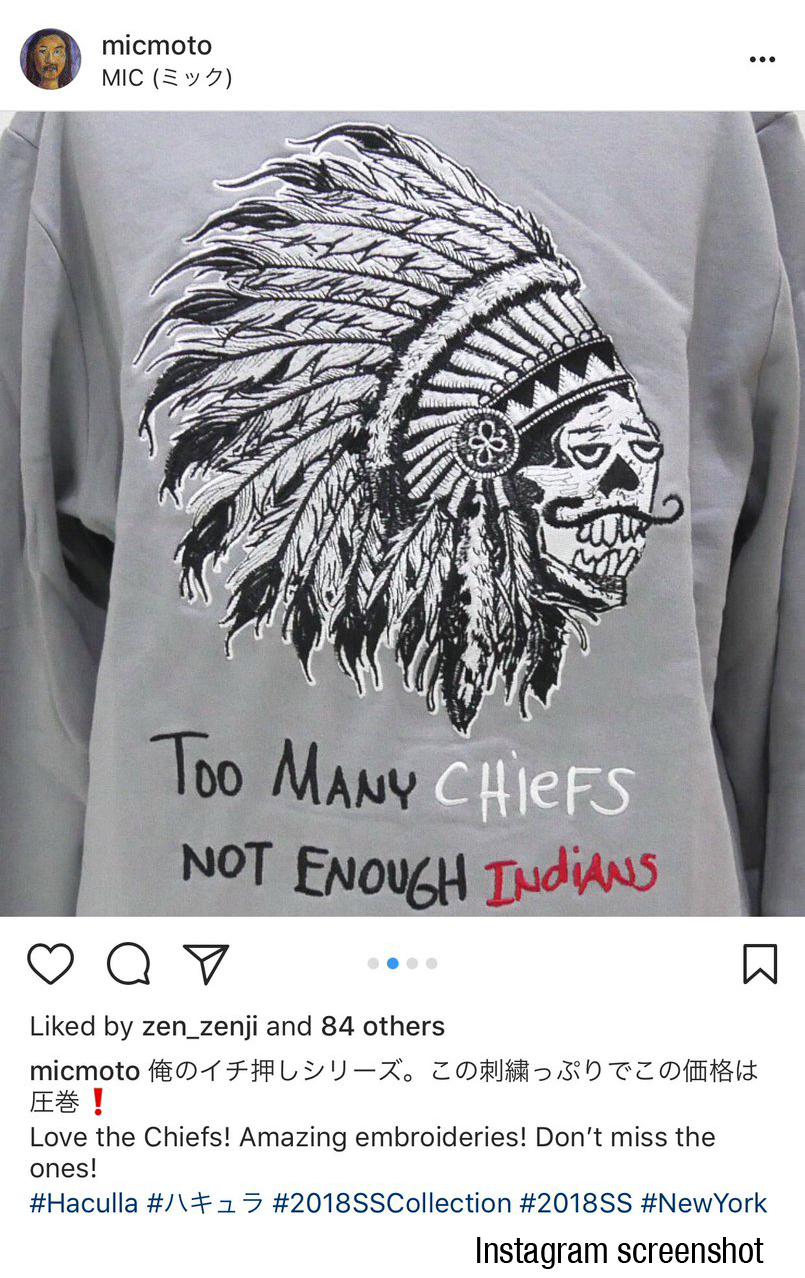Sometime in February of 2018, Japanese jewelry and accessory designer Mic Moto posted on his Facebook Page a set of pullovers with a skull with a mustache wearing a headdress. One of the slogans on a design reads, “too many chiefs, not enough Indians”. I posted a tweet about it and made a comment in the Facebook Page post about the negative imagery regarding Native Americans, specifically Plains tribes who hold the headdress to be sacred. The reply had been marked as ‘spam’, though it’s not clear if it was by Mic himself or some other avenue. I had to submit to Facebook that it wasn’t spam and it seemed to become visible up until the post vanished.
A Japanese designer I follow posted this pic. I commented how negative a skull in a headdress is and my comment was marked as spam on Facebook. Not sure if he marked it since it was right away. But still. https://t.co/9Bg4hDcuTy pic.twitter.com/XSONeqHjxZ
— Ali Watson (@aliwatson117) February 11, 2018
From Mic’s Instagram 😞 Does this design celebrate our genocide? Somehow supposed to honor us? I really do not understand. pic.twitter.com/p03gR1p28a
— Ali Watson (@aliwatson117) February 12, 2018
As many of us know, this type of imagery has been controversial for some time, yet the skull in a headdress motif persists, much like its cousin the non-Native chick in a headdress. The design itself is interesting in that a headdress is associated with an individual who has earned it, which means that these designs are of a dead and beheaded Indian wearing a headdress, symbolism for our extinction. Headdresses are also not made in bulk and exchanged like trading cards.
We as a people are not extinct. We are still here. However ‘badass’ non-Natives like to view this type of imagery, it’s an insult to the tribes who hold those headdresses sacred. The link to the Facebook Page is broken because after a few Natives pointed out how negative the imagery is and to not use it, rather than address those concerns, the post was deleted.
In the Japanese music scene, Mic’s goods are often worn by Japanese musicians, artists and, subsequently, seen by their fans. One of my favorite bands, Dir en grey, seems to have been marred by Mic having the guitarist, Die, wearing one of those hoodies. While Die isn’t visible in any recognizable sense of the picture as it’s from the back, Mic tagged Die, Dir en grey and DECAYS, Die’s solo project, in this Instagram post (scroll to the fourth pic):
I’d like to point out that it’s very unlikely that Die knew how insulting this imagery is to Natives. I would like to believe that he merely modeled it as he’s done many other of Mic’s work. I don’t excuse Mic because he’s actually gone on a road trip through the south west of the U.S. in Arizona and New Mexico where he spent time at the Santa Fe Indian Market viewing plenty of authentic Native American jewelry, crafts and art. I even left a comment on the last Instagram link.
If that wasn’t enough, on March 10th, Mic announced that Maya Stewart’s works would be part of his shop in an ameba blog post. In the second pic is a bag/pouch with a skull in a headdress design.
Maya Stewart, according to her webpage, is Chickasaw, Choctaw and Creek. “As a Native American of Chickasaw, Creek and Choctaw descent, Maya’s designs are frequently influenced by the geometric lines of Southeastern tribes.” The laughable part of this ‘bio’ is that headdresses are associated primarily with Northern Plains tribes. Not a single one of her supposed tribes wore headdresses and yet she’s making skull in headdress designs for Mic Moto. This is prime sellout tactics in exploiting images and items sacred to other tribes in an aim to make a buck and subscribe to a non-Native’s seeming desire for that imagery.
Talking to you, @mayastewart! This skull and headdress is part of your collection, right? pic.twitter.com/OJ9axIS6X0
— Ali Watson (@aliwatson117) March 14, 2018
It’s my hope that in the future, Mic Moto will withdraw this type of negative imagery from his designs rather than further it. Hopefully Maya Stewart will learn not to exploit other tribes, if she’s actually Native. There are a ton of incredible Native and First Nations artisans who could be approached for respectful representation.
